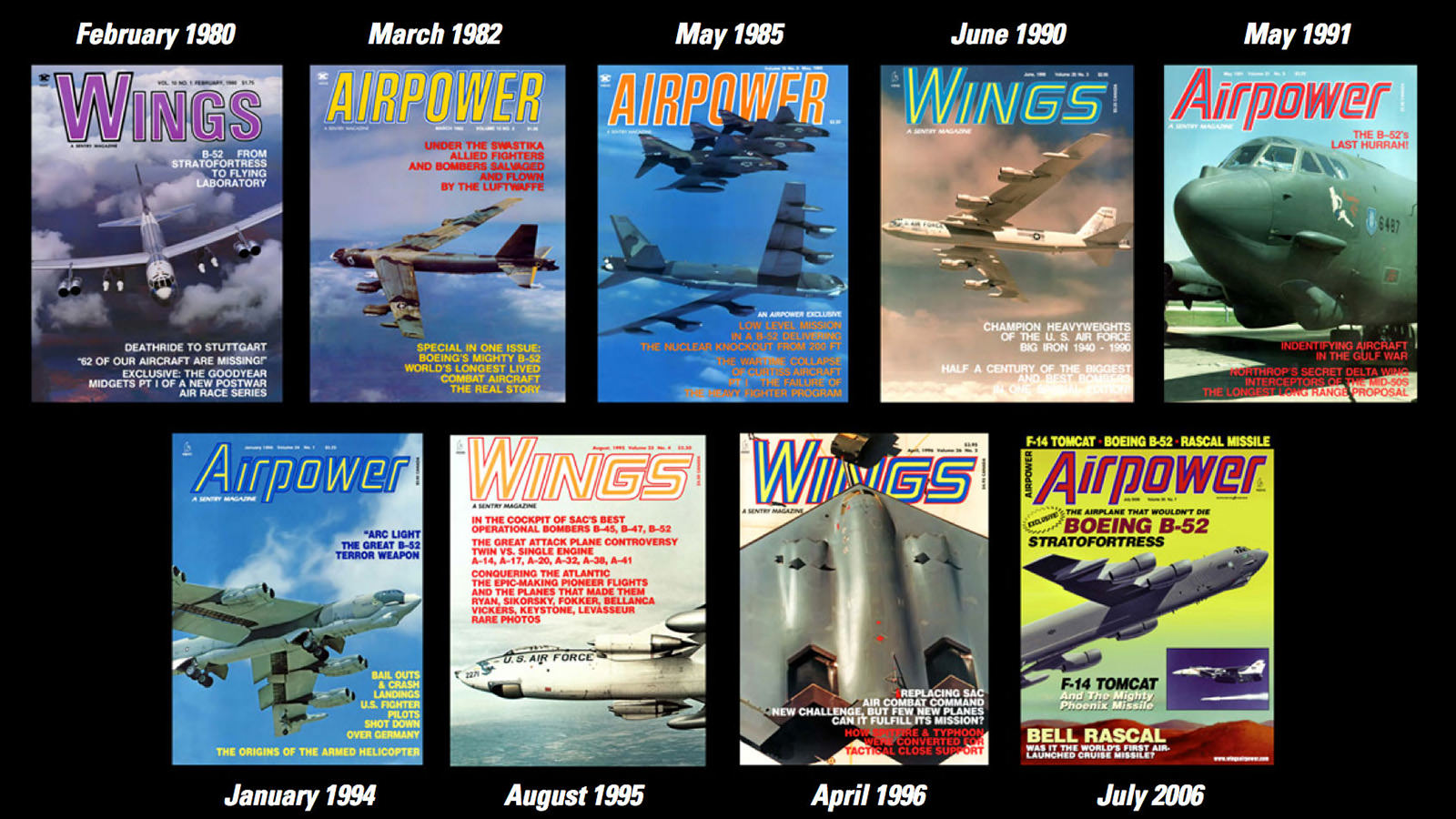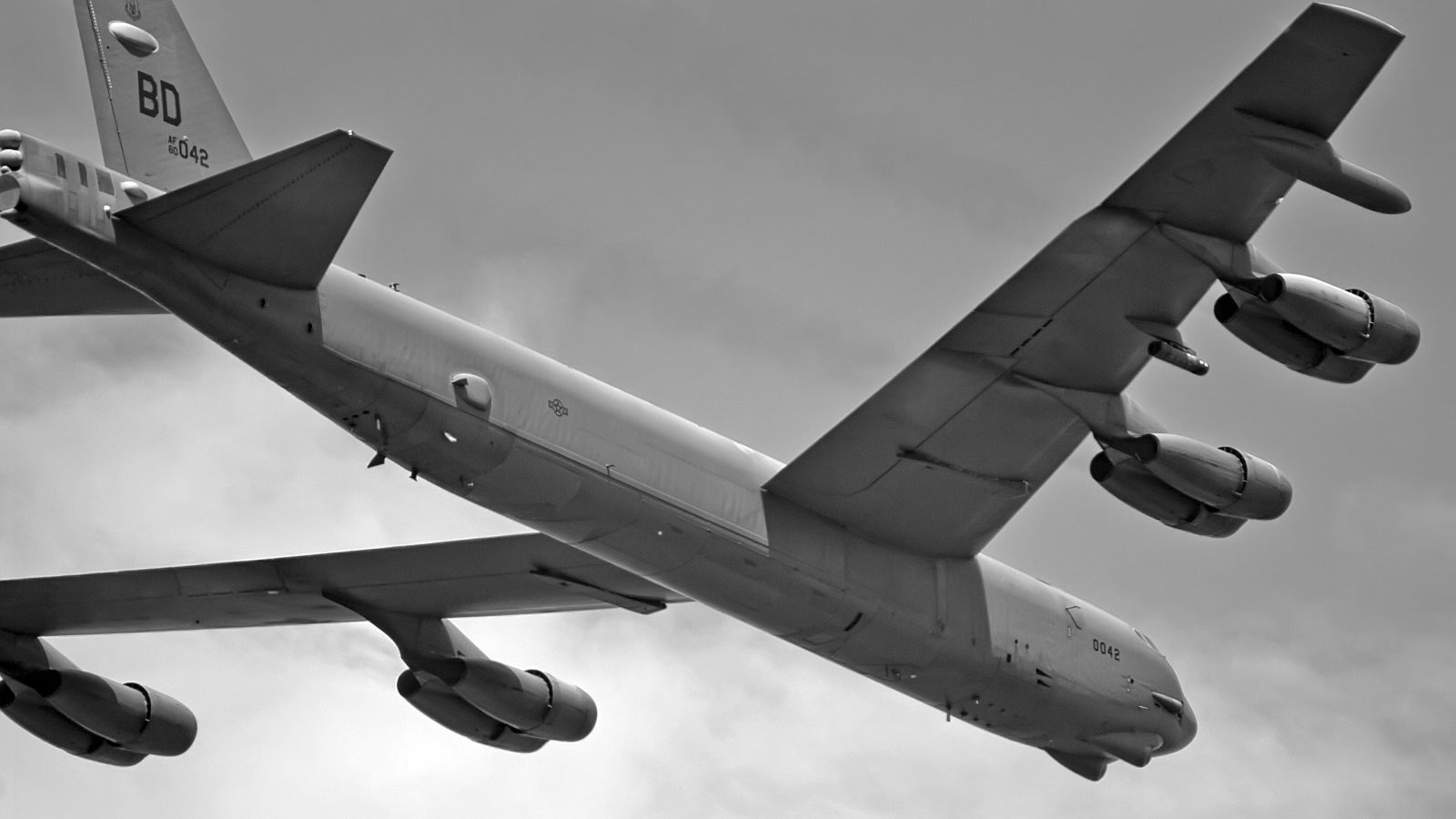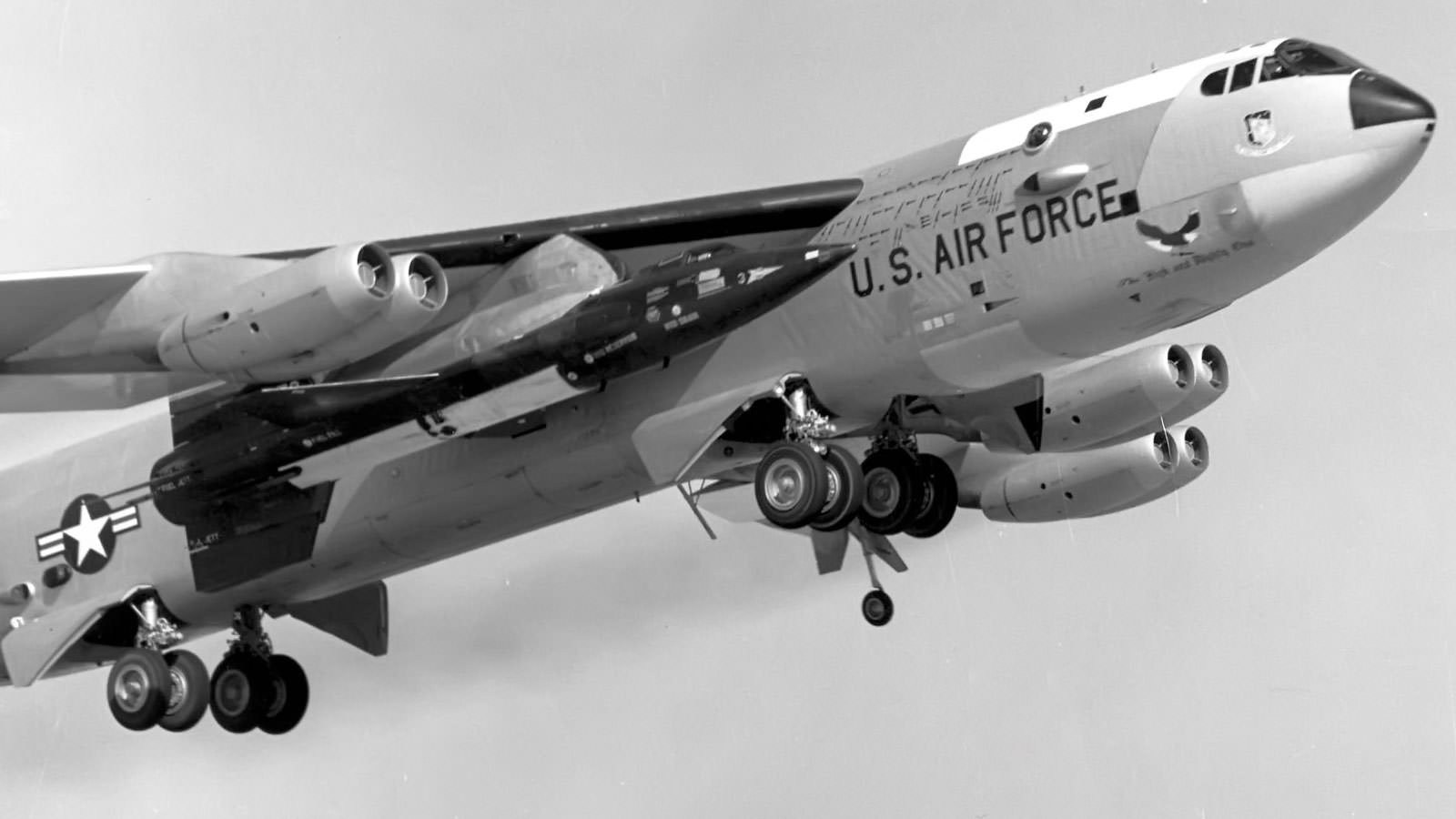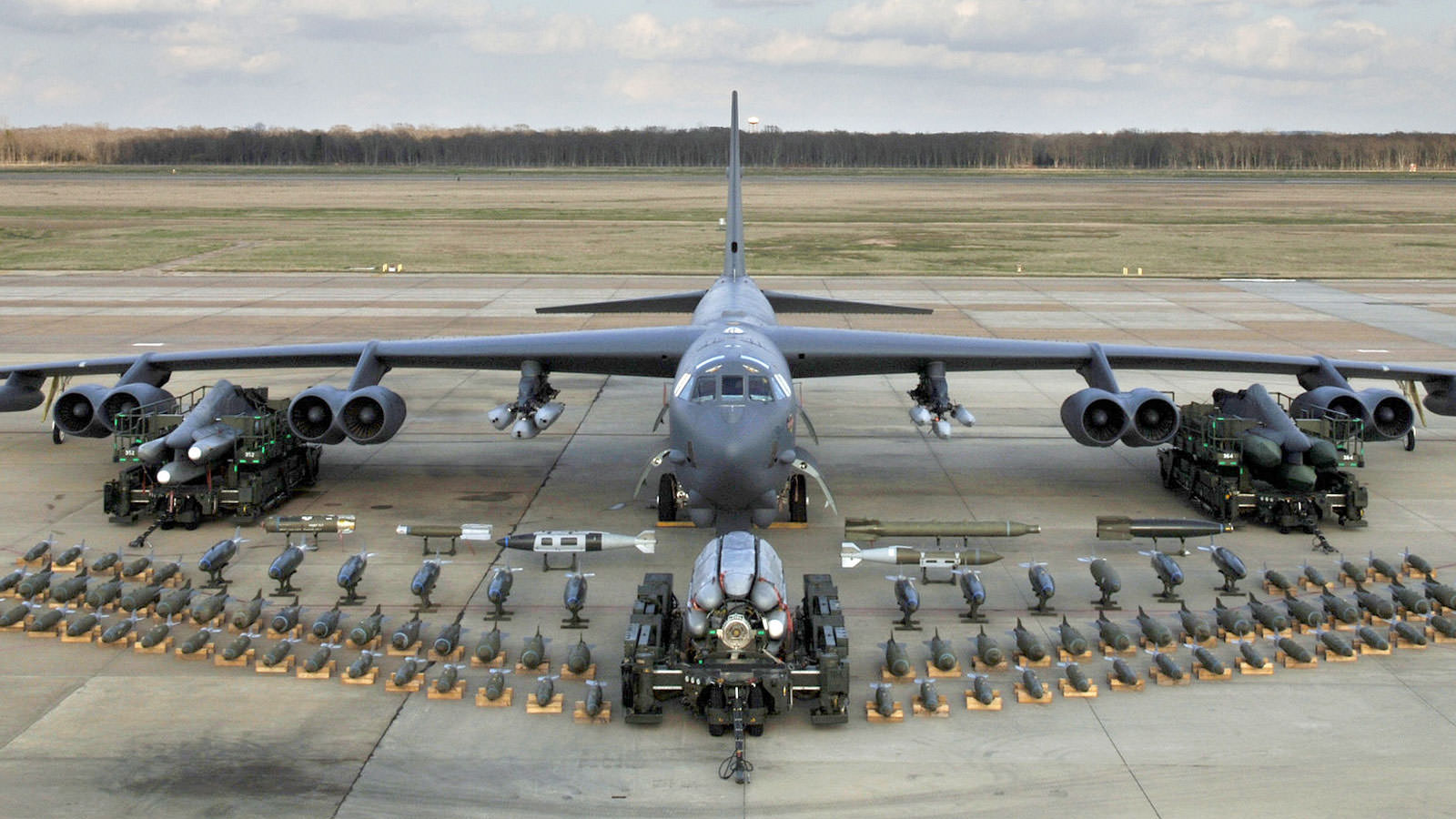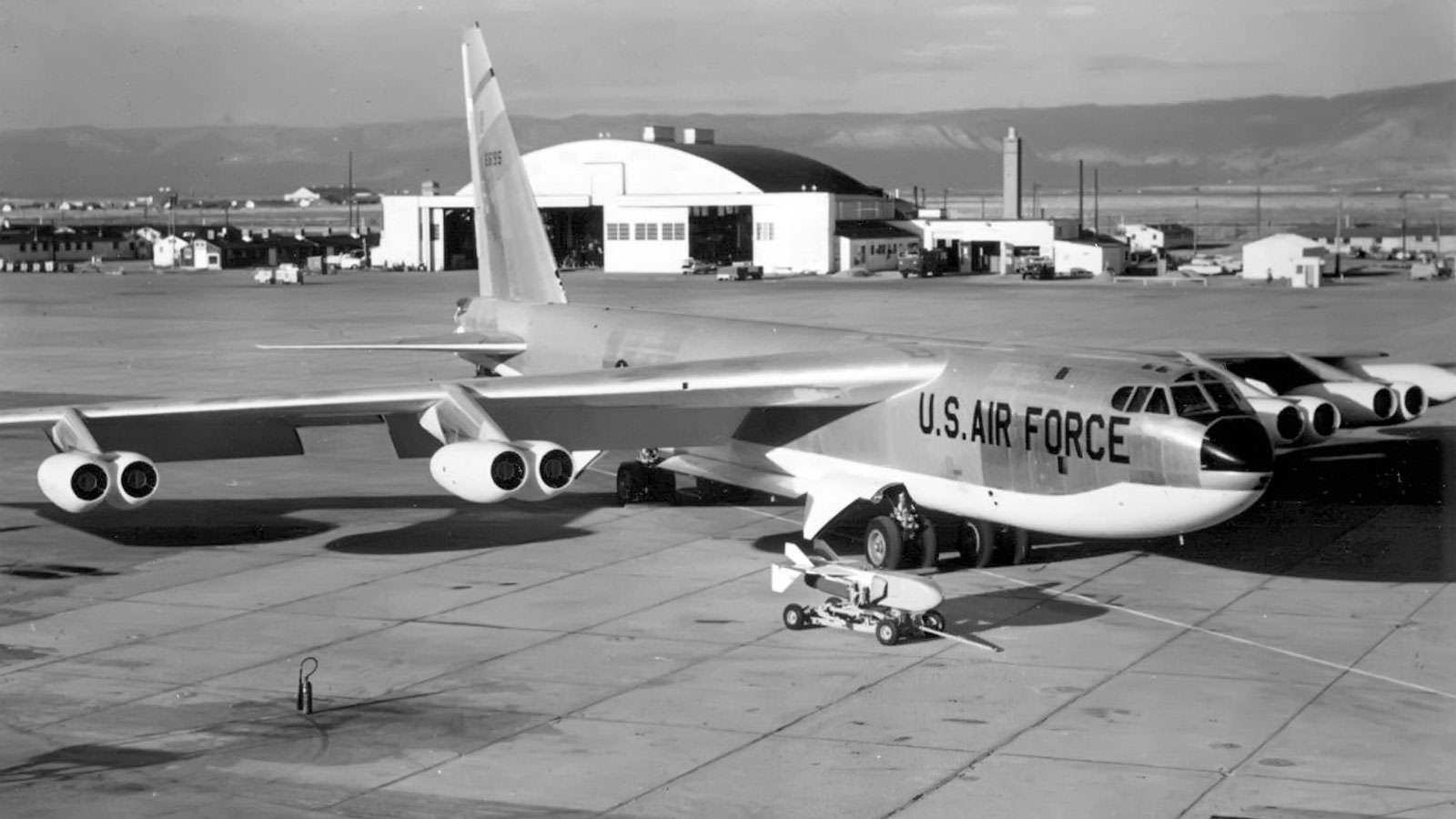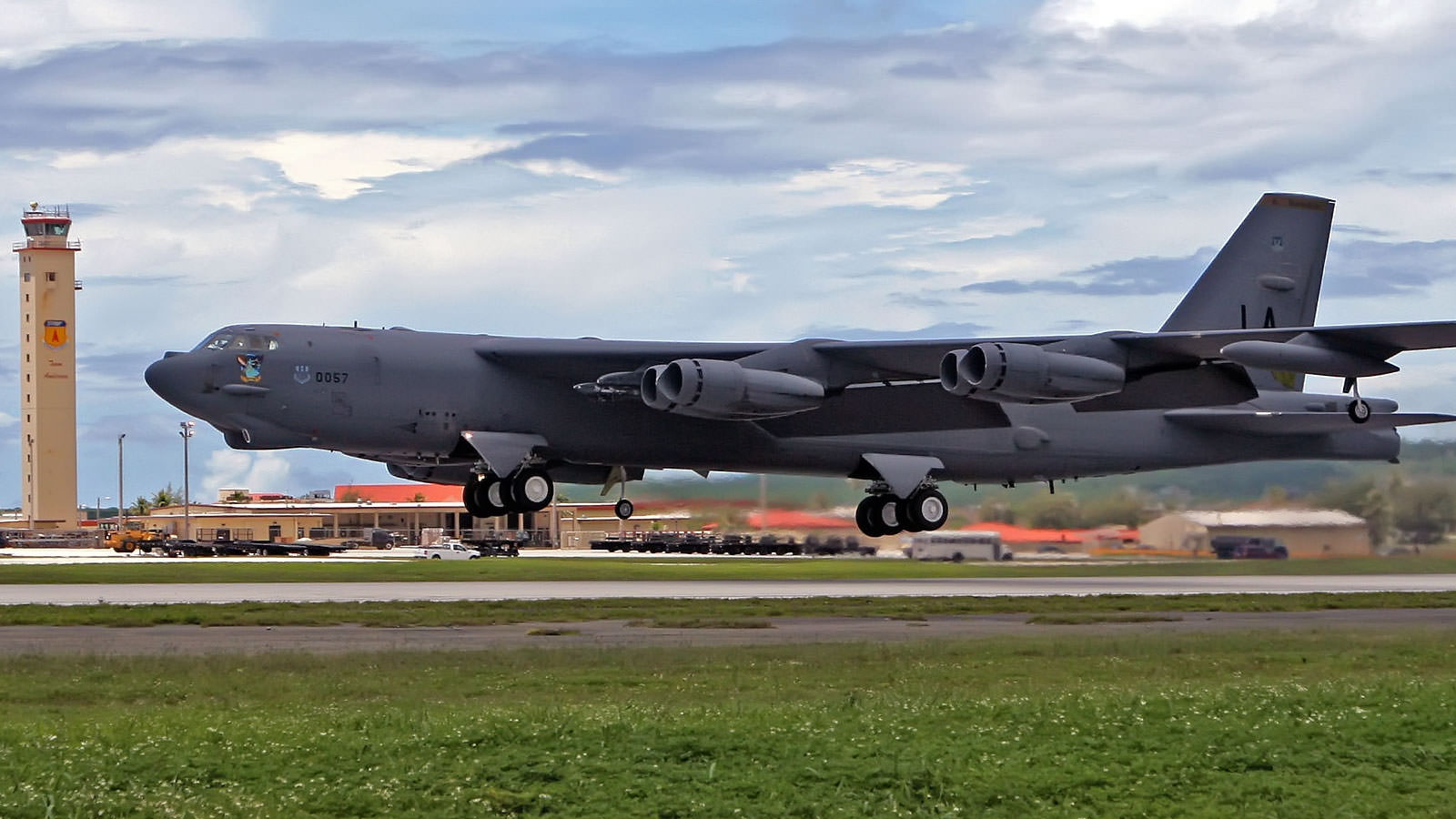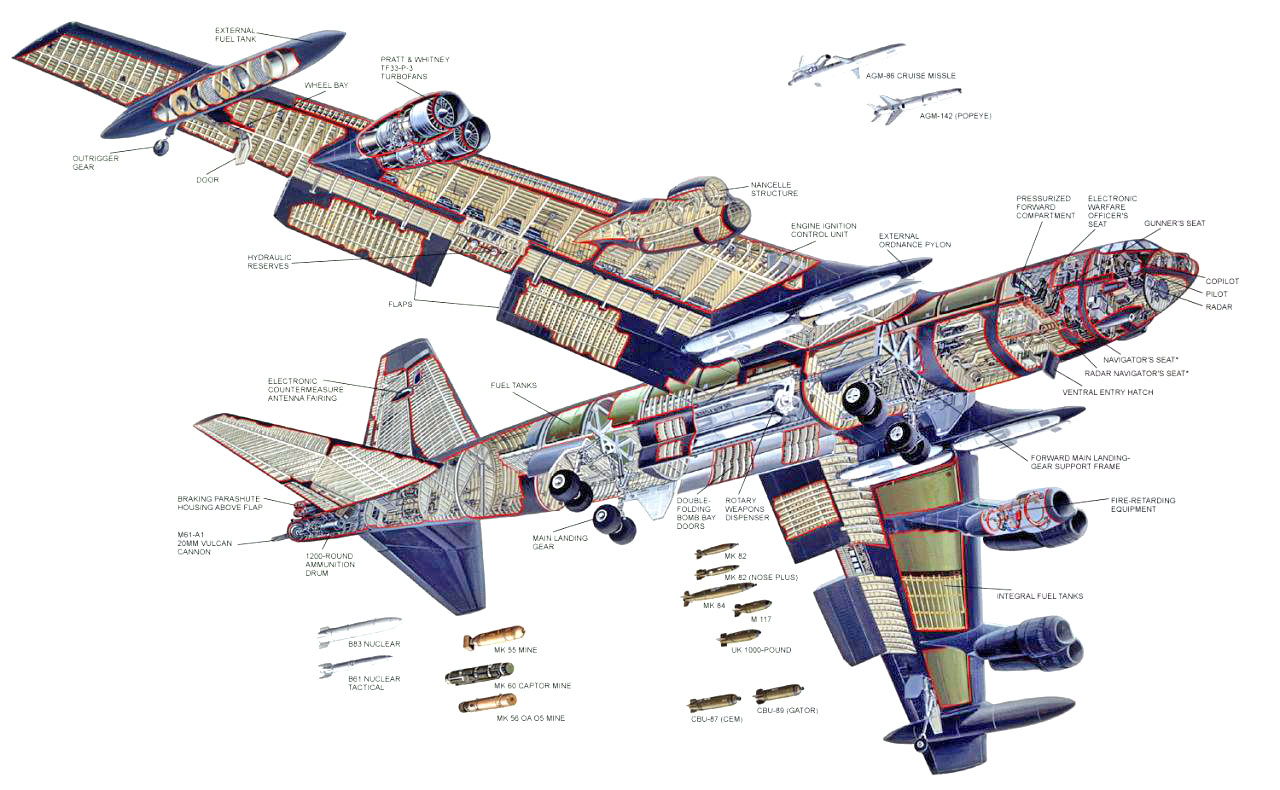Price: $49.95
- 9 magazines, 16 manuals, & photos
- PDF contains 9,422 pages
- Content is keyword searchable
- Print a personal copy
- Pay via PayPal or Credit Card
- International orders welcome!
- Download files upon payment
February 1980
- B-52 from Stratofortress to Flying Laboratory
- Deathride to Stuttgart
- Goodyear Midgets Air Racing Series
March 1982
- Boeing’s Mighty B-52, Longest Lived Combat Aircraft
- Allied Fighters & Bombers flown by the Luftwaffe
May 1985
- B-52 Low-Level Mission Delivering Nuclear Knockout
- Wartime Collapse of Curtiss Aircraft
June 1990
- Big Iron of the US Air Force, 1940-1990
May 1991
- The B-52’s Last Hurrah
- Identifying Gulf War Aircraft
- Northrop’s Secret Delta Wing Interceptors of the 1950s
August 1995
- In the cockpit of SAC’s Best Operational Bombers – B-45, B-47, B-52
- Great Attack Plane Controversy, Twin vs. Single Engine
- Conquering the Atlantic, Epic Pioneer Flights
January 1994
- Arc Light, The Great B-52 Terror Weapon
- Bailouts and Crash Landings
- Origins of the Armed Helicopter
April 1996
- Replacing SAC Air Combat Command
- How Spitfire & Typhoon were Converted for Tactical Close Support
July 2006
- Boeing B-52, The Airplane That Wouldn’t Die
- F-14 Tomcat and the Mighty Phoenix Missile
- Bell Rascal, World’s First Air-Launced Cruise Missile?
Manuals & Photos
- B-52C/D Flight Manual
- B-52D Performance Data
- B-52E/F Flight Manual
- B-52G Flight Manual
- B-52H Flight Manual
- B-52H Radar Navigators Manual
- B-52H Performance Data
- B-52H Weight Checklist Loading Data
- B-52H Electronic Warfare Officers Manual
- B-52 AGM-84D Weapons Delivery
- B-52H AGM-86 Weapons Delivery
- B-52 AGM-142 Weapons Delivery
- B-52 AGM-154 Weapons Delivery
- B-52H AGM-158 Weapons Delivery
- B-52 JDAM Weapons Delivery
- B-52 WCMD Weapons Delivery
- And over 750 B-52 photos!
Boeing B-52 Stratofortress
B-58H Specifications
Variants
On Display
Cutaway
General Characteristics

- Crew: 5 (pilot, copilot, radar navigator (bombardier), navigator, and Electronic Warfare Officer)(Originally, there was an additional crew member – the tail gunner. This position was eliminated with removal of the tail gun in 1991.)
- Length: 159 ft 4 in (48.5 m)
- Wingspan: 185 ft 0?in (56.4 m)
- Height: 40 ft 8?in (12.4 m)
- Wing area: 4,000 sq ft (370 m²)
- Airfoil: NACA 63A219.3 mod root, NACA 65A209.5 tip
- Empty weight: 185,000 lb (83,250 kg)
- Loaded weight: 265,000 lb (120,000 kg)
- Max. takeoff weight: 488,000 lb (220,000 kg)
- Powerplant: 8 × Pratt & Whitney TF33-P-3/103 turbofans, 17,000 lbf (76 kN) each
- Fuel capacity: 47,975 U.S. gal (39,948 imp gal; 181,610 L)
- Zero-lift drag coefficient: 0.0119 (estimated)
- Drag area: 47.60 sq ft (4.42 m²)
- Aspect ratio: 8.56
Performance
- Maximum speed: 560 kt (650 mph, 1,047 km/h)
- Cruise speed: 442 kt (525 mph, 844 km/h)
- Combat radius: 4,480 mi (3,890 nmi, 7,210 km)
- Ferry range: 10,145 mi (8,764 nmi, 16,232 km)
- Service ceiling: 50,000 ft (15,000 m)
- Rate of climb: 6,270 ft/min (31.85 m/s)
- Wing loading: 120 lb/ft² (586 kg/m²)
- Thrust/weight: 0.31
- Lift-to-drag ratio: 21.5 (estimated)
Armament
- Guns: 1× 20 mm (0.787 in) M61 Vulcan cannon originally mounted in a remote controlled tail turret on the H-model, removed from all current operational aircraft in 1991
- Bombs: Approximately 70,000 lb (31,500 kg) mixed ordnance; bombs, mines, missiles, in various configurations
Avionics
- Electro-optical viewing system that uses platinum silicide forward-looking infrared and high resolution low-light-level television sensors
- ADR-8 chaff rocket (1965-1970)
- LITENING Advanced Targeting System
- Sniper Advanced Targeting Pod
- IBM AP-101 computer
- XB-52
- Two prototype aircraft with limited operational equipment, used for aerodynamic and handling tests
- YB-52
- One XB-52 modified with some operational equipment and re-designated
- B-52A
- Only three of the first production version, the B-52A, were built, all loaned to Boeing for flight testing. The first production B-52A differed from prototypes in having a redesigned forward fuselage. The bubble canopy and tandem seating was replaced by a side-by-side arrangement and a 21 in (53 cm) nose extension accommodated more avionics and a new sixth crew member. In the rear fuselage, a tail turret with four 0.50 inch (12.7 mm) machine guns with a fire-control system, and a water injection system to augment engine power with a 360 US gallon (1,363 L) water tank were added. The aircraft also carried a 1,000 US gallon (3,785 L) external fuel tank under each wing. The tanks damped wing flutter and also kept wingtips close to the ground for ease of maintenance.
- NB-52A
- The last B-52A (serial 52-0003) was modified and redesignated NB-52A in 1959 to carry the North American X-15. A pylon was fitted under the right wing between the fuselage and the inboard engines with a 6 feet x 8 feet (1.8 m x 2.4 m) section removed from the right wing flap to fit the X-15 tail. Liquid oxygen and hydrogen peroxide tanks were installed in the bomb bays to fuel the X-15 before launch. Its first flight with the X-15 was on 19 March 1959, with the first launch on 8 June 1959. The NB-52A, named “The High and Mighty One” carried the X-15 on 93 of the program’s 199 flights.
- B-52B/RB-52B
The B-52B was the first version to enter service with the USAF on 29 June 1955 with the 93rd Bombardment Wing at Castle AFB in California. This version included minor changes to engines and avionics, enabling an extra 12,000 pounds of thrust using water injection. Temporary grounding of the aircraft after a crash in February 1956 and again the following July caused training delays, and at mid-year there were still no combat-ready B-52 crews.
Of the 50 B-52Bs built, 27 were capable of carrying a reconnaissance pod as RB-52Bs (the crew was increased to eight in these aircraft). The 300 pound (136 kg) pod contained radio receivers, a combination of K-36, K-38, and T-11 cameras, and two operators on downward-firing ejection seats. The pod required only four hours to install. Seven B-52Bs were brought to B-52C standard under Project Sunflower.
- NB-52B
- The NB-52B was B-52B number 52-0008 converted to an X-15 launch platform. It subsequently flew as the “Balls 8” in support of NASA research until 17 December 2004, making it the oldest flying B-52B. It was replaced by a modified B-52H.
- B-52C
- The B-52C’s fuel capacity (and range) was increased to 41,700 US gallons by adding larger 3000 US gallon underwing fuel tanks. The gross weight was increased by 30,000 pounds (13,605 kg) to 450,000 pounds. A new fire control system, the MD-9, was introduced on this model. The belly of the aircraft was painted with antiflash white paint, which was intended to reflect thermal radiation away after a nuclear detonation.
- RB-52C
- The RB-52C was the designation initially given to B-52Cs fitted for reconnaissance duties in a similar manner to RB-52Bs. As all 35 B-52Cs could be fitted with the reconnaissance pod, the RB-52C designation was little used and was quickly abandoned.
- B-52D
- The B-52D was a dedicated long-range bomber without a reconnaissance option. The Big Bellymodifications allowed the B-52D to carry heavy loads of conventional bombs for carpet bombing over Vietnam, while the Rivet Rambler modification added the Phase V ECM systems, which was better than the systems used on most later B-52s. Because of these upgrades and its long range capabilities, the D model was used more extensively in Vietnam than any other model. Aircraft assigned to Vietnam were painted in a camouflage colour scheme with black bellies to defeat searchlights.
- B-52E
- The B-52E received an updated avionics and bombing navigational system, which was eventually debugged and included on following models. One E aircraft (AF Serial No. 56-0631) was modified as a testbed for various B-52 systems. Redesignated NB-52E, the aircraft was fitted with canards and a Load Alleviation and Mode Stabilization system (LAMS) which reduced airframe fatigue from wind gusts during low level flight. In one test, the aircraft flew 10 knots (11.5 mph, 18.5 km/h) faster than the never exceed speed without damage because the canards eliminated 30% of vertical and 50% of horizontal vibrations caused by wind gusts.
- B-52F
- This aircraft was given J57-P-43W engines with a larger capacity water injection system to provide greater thrust than previous models. This model had problems with fuel leaks which were eventually solved by several service modifications: Blue Band, Hard Shell, and QuickClip.
- B-52G
- The B-52G was proposed to extend the B-52’s service life during delays in the B-58 Hustlerprogram. At first, a radical redesign was envisioned with a completely new wing and Pratt & Whitney J75 engines. This was rejected to avoid slowdowns in production, although a large number of changes were implemented. The most significant of these was the brand-new “wet” wing with integral fuel tanks which considerably increased the fuel capacity; gross aircraft weight went up by 38,000 pounds (17,235 kg) compared with prior variants. In addition, a pair of 700 US gallon (2,650 L) external fuel tanks was fitted under the wings. In this model, the traditional ailerons were eliminated. Instead, spoilers provided roll control. The tail fin was shortened by 8 feet (2.4 m), water injection system capacity was increased to 1,200 US gallons (4,540 L), and the nose radome was enlarged. The tail gunner manning the 4 .50 caliber machine guns (quad mounted in a remote controlled tail turret on the G-model (ASG-15), the guns were later removed from all operational aircraft) was relocated to the main cockpit and was provided with an ejection seat. Dubbed the “Battle Station” concept, the offensive crew (pilot and copilot on the upper deck and the two bombing navigation system operators on the lower deck) faced forward, while the defensive crew (tail gunner and ECM operator) on the upper deck faced aft. The B-52G entered service on 13 February 1959 (a day earlier, the last B-36 was retired, making SAC an all-jet bomber force). 193 B-52Gs were produced, making this the most produced B-52 variant. Most B-52Gs were destroyed in compliance with the 1992 Strategic Arms Reduction Treaty; the last B-52G, number 58-0224, was dismantled under New START treaty requirements in December 2013. A few examples remain on display for museums.
- B-52H
- The B-52H had the same crew and structural changes as the B-52G. The most significant upgrade was the switch to TF33-P-3 turbofan engines which, despite the initial reliability problems (corrected by 1964 under the Hot Fan program), offered considerably better performance and fuel economy than the J57 turbojets. The ECM and avionics were updated, a new fire control system was fitted, and the rear defensive armament was changed from machine guns to a 20 mm M61 Vulcan cannon (later removed in 1991–94). The final 18 aircraft were manufactured with provision for the ADR-8 countermeasures rocket, which was later retrofitted to the remainder of the B-52G and B-52H fleet. A provision was made for four GAM-87 Skybolt ballistic missiles. The aircraft’s first flight occurred on 10 July 1960, and it entered service on 9 May 1961. This is the only variant still operational. A total of 102 B-52Hs were built. The last production aircraft, B-52H AF Serial No. 61-0040, left the factory on 26 October 1962.
- XR-16A
- Allocated to the reconnaissance variant of the B-52B but not used and the aircraft were designated RB-52B instead.
Australia
- B-52G
- 59-2596 “2596 Darwin’s Pride” – Australian Aviation Heritage Centre in Darwin, Australia.
South Korea
- B-52D
- 55-0105 – War Memorial of Korea, Seoul, was operated by the 4258 SW at U-Tapao RTAFB in Thailand and the 96 BW at Dyess AFB, Texas.
United Kingdom
- B-52D
- 56-0689 – Imperial War Museum Duxford, Duxford, England, was operated by the 28th BW and 7th BW at Carswell AFB.
United States
- NB-52A
- 52-0003 – Pima Air & Space Museum adjacent to Davis-Monthan Air Force Base in Tucson, Arizona. It is a converted B-52A that was used by the Air Force Flight Test Center at Edwards AFB, California as the X-15 Launch Aircraft; now on display and marked as 0003 The High and the Mighty One.
- B-52B
- 52-0005 – Wings Over the Rockies Air and Space Museum (former Lowry AFB), Denver, Colorado. It is marked as “005 “, and was accepted on 3 March 1955. It was operated by the 6515th Maintenance Group (Air Research & Development Command) at Edwards AFB, 93rd BW / 330th BS at Castle AFB, 3415th MSG (ATC) at Lowry AFB, then redesignated as a GB-52B training airframe at the Lowry Technical Training Center, withdrawn from service April 1982.
- NB-52B
- 52-0008 – Edwards AFB Museum, California. It is marked as “0008”, originally a B-52B then modified as a RB-52B then NB-52B. Assigned to NASA as Balls 8 for use as a mothership for the X-15, X-38, and X-43A, withdrawn from service on 17 December 2004.
- RB-52B
- 52-0013 – National Atomic Museum adjacent to Kirtland AFB in Albuquerque, New Mexico. One of the few B-52s to have actually dropped a nuclear weapon when it took part in Operation Dominic in 1962.
- 52-8711 – Strategic Air & Space Museum adjacent to Offutt AFB in Ashland, Nebraska. It was originally a B-52B, and was the first operational B-52 delivered to SAC’s 93d Bombardment Wing in June 1955.
- 53-0379 – Although not preserved as such, the aircraft sits on the edge of Rogers Dry Lake south of Edwards Air Force Base. It was used for barrier testing until 1970, and has been located on the photo range for some time.
- B-52D
- 55-0057 – Maxwell Air Force Base, Alabama. It was operated by the 306th BW at McCoy AFB, Florida and the 7th BW at Carswell AFB, Texas.
- 55-0062 – K.I. Sawyer Heritage Air Museum on the former K.I. Sawyer AFB, Michigan. It was accepted by the USAF in February 1957.
- 55-0067 – Pima Air & Space Museum, adjacent to Davis-Monthan AFB in Tucson, Arizona. It is marked as “067 The Lone Star Lady” and was operated by the 7th BW at Carswell AFB and withdrawn from service on 5 November 1982.
- 55-0068 – USAF History & Traditions Museum, Lackland AFB, San Antonio, Texas.
- 55-0071 – Battleship Memorial Park, Mobile, Alabama.
- 55-0083 – United States Air Force Academy, Colorado Springs, Colorado.
- 55-0085 – Museum of Aviation, Robins AFB, Warner Robins, Georgia. It was operated by the 99th BW at Andersen AFB, Guam and the 7th BW at Carswell AFB, Texas.
- 55-0094 – Kansas Aviation Museum, Wichita, Kansas. It was accepted by the USAF on 30 April 1957 and participated in Arclight.[
- 55-0677 – Yankee Air Museum, Willow Run Airport, Ypsilanti, Michigan. It is marked as “677”and was operated by the 43rd BW at Andersen AFB, Guam and participated in Linebacker II aspart of the 96th BW at Dyess AFB, Texas.
- 55-0679 – March Field Air Museum, March Air Reserve Base (former March AFB) in Riverside, California. It is marked as “679” and was accepted by the USAF on 5 June 1957 and operated by the 92nd BW at Ellsworth AFB, South Dakota; 494th BW at Sheppard AFB, Texas; 509th BW at Pease AFB, New Hampshire and Andersen AFB, Guam; 454th BW at March AFB, California; 22nd BW at Andersen AFB, Guam; 99th BW at Andersen AFB and U-Tapao RTAFB, Thailand;, 43rd SW at U-Tapao RTAFB;, 7th BW at Carswell AFB, Texas; 99th BW at Andersen AFB and U-Tapao; 22nd BW at March AFB; 43rd SW at Andersen AFB and participated in Linebacker II;, 7th BW at Carswell AFB; 22nd BW at March AFB, 175 combat missions, became a training airframe as a GB-52D and withdrawn from service in 1992.
- 56-0585 – Air Force Flight Test Center Museum, Edwards AFB, California.
- 56-0586 – Arc Light Memorial, Andersen AFB, Guam
- 56-0589 – Sheppard AFB Air Park, Sheppard AFB, Wichita Falls, Texas.
- 56-0612 – Castle Air Museum at the former Castle AFB, Atwater, California.
- 56-0629 – Eighth Air Force Museum, Barksdale AFB, Louisiana. It is marked as “0629” and was accepted by the USAF in October 1957 and was operated by the 4258SW at U-Tapao.
- 56-0657 – South Dakota Air and Space Museum, Ellsworth AFB, Rapid City, South Dakota.
- 56-0659 – Warrior Park, Davis-Monthan AFB, Tucson, Arizona (dismantled in February 2012).
- 56-0665 – National Museum of the United States Air Force, Wright-Patterson AFB, Dayton, Ohio.
- 56-0676 – Armed Forces & Aerospace Museum, Fairchild AFB, Washington. It operated in the Vietnam War and participated in Operation Linebacker II (aka Christmas Bombings), credited as a MiG Killer on 18 December 1972 when Tail gunner SSgt Samuel O. Turner downed a MiG-21. Also based with the 96th BW at Dyess AFB, Texas.
- 56-0683 – Whiteman AFB, Missouri.
- 56-0685 – Dyess Linear Air Park, Dyess AFB, Abilene, Texas.
- 56-0687 – B-52 Memorial Park, Orlando International Airport (former McCoy AFB), Orlando, Florida. It was operated by the 7th BW at Carswell AFB, Texas.
- 56-0695 – Tinker AFB, Oklahoma City, Oklahoma.
- 56-0696 – Jimmy Doolittle Air & Space Museum, Travis Air Force Base, Fairfield, California. It is marked as “Twilight D’Lite“.
- B-52E
- 57-0119 – As with 53-0379, it is located on the Edwards Air Force Base photo range in destroyed condition. It was used in a variety of test roles, most notably as the carrier for the General Electric TF39 engine used on the C-5 Galaxy. It was towed to its present location in 1980, and blown up in 1991 to satisfy conditions of the Strategic Arms Reduction Treaty.
- B-52F
- 57-0038 – Palmdale Airpark, Air Force Plant 42, Palmdale, California. This is the only preserved B-52F. It was on display at the Oklahoma City Fairgrounds from 1974 to 2006.
- B-52G
- 57-6468 – Gate guard at Offutt AFB, Bellevue, Nebraska.
- 57-6509 – Eighth Air Force Museum at Barksdale Air Force Base, Louisiana. It is marked as “6509 Nine O Nine II” and was operated by the 2nd BW at Barksdale AFB and the 801st BW(P) at Moron AB, Spain during Operation Desert Storm.
- 58-0183 – Pima Air & Space Museum adjacent to Davis-Monthan Air Force Base in Tucson, Arizona. It is marked as ” 0183 Valkyrie “ and was operated by the 2nd BW / 596th BS at Barksdale AFB, assigned in January 1991 to Operation Secret Squirrel, withdrawn from service in July 1991.
- 58-0185 – Air Force Armament Museum at Eglin AFB, Florida. It is marked as “0185 El Lobo II” and first assigned to the 4135th Strategic Wing, Strategic Air Command, Eglin AFB, September 1959; last assigned to the 2nd Bomb Wing, Barksdale AFB, Louisiana.
- 58-0191 – Hill Aerospace Museum at Hill AFB, Utah. It is marked as “0191 Bearin’ Arms” and was accepted into service on 16 October 1959 and operated by the 72nd BW at Ramey AFB, Puerto Rico; 456th BW at Beale AFB, California and Andersen AFB, Guam; 17th BW at Andersen AFB, Guam and Robins AFB, Georgia; 2nd BW at Barksdale AFB, Louisiana; 320th BW at Mather AFB, California; 97th BW at Blytheville AFB, Arkansas and Edwards AFB, California; 62nd BW at Fairchild AFB, Washington; 93rd BW at Castle AFB, California; 2nd BW at Barksdale AFB, 93rd BW at Castle AFB, then withdrawn from service in August 1991.
- 58-0225 – Griffiss Air Force Base Museum (former Griffiss AFB) in Rome, New York. It is marked as “0225 Mohawk Valley” and was operated by the 416th BW.
- 59-2577 – Grand Forks Air Force Base, North Dakota.
- 59-2584 – Museum of Flight in Seattle, Washington.
- 59-2601 – Langley Air Force Base, Virginia.


